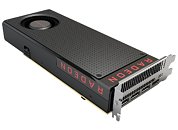- Joined
- Oct 9, 2007
- Messages
- 47,847 (7.39/day)
- Location
- Dublin, Ireland
| System Name | RBMK-1000 |
|---|---|
| Processor | AMD Ryzen 7 5700G |
| Motherboard | Gigabyte B550 AORUS Elite V2 |
| Cooling | DeepCool Gammax L240 V2 |
| Memory | 2x 16GB DDR4-3200 |
| Video Card(s) | Galax RTX 4070 Ti EX |
| Storage | Samsung 990 1TB |
| Display(s) | BenQ 1440p 60 Hz 27-inch |
| Case | Corsair Carbide 100R |
| Audio Device(s) | ASUS SupremeFX S1220A |
| Power Supply | Cooler Master MWE Gold 650W |
| Mouse | ASUS ROG Strix Impact |
| Keyboard | Gamdias Hermes E2 |
| Software | Windows 11 Pro |
AMD on 19th July, released a WHQL-signed version of Radeon Software Crimson Edition 16.7.2 drivers. The company first released the RSCE 16.7.2 as a Beta on the 12th of July. The change-log of the new 16.7.2 WHQL drivers don't say exactly what is different between the 16.7.2 Beta and the 16.7.2 WHQL; so we guess it's just 16.7.2 with WHQL certification. Grab the drivers from the links below.

DOWNLOAD: AMD Radeon Software Crimson Edition 16.7.2 WHQL for Windows 10 64-bit | Windows 10 32-bit | Windows 8.1 64-bit | Windows 8.1 32-bit | Windows 7 64-bit | Windows 7 32-bit
View at TechPowerUp Main Site

DOWNLOAD: AMD Radeon Software Crimson Edition 16.7.2 WHQL for Windows 10 64-bit | Windows 10 32-bit | Windows 8.1 64-bit | Windows 8.1 32-bit | Windows 7 64-bit | Windows 7 32-bit
View at TechPowerUp Main Site






